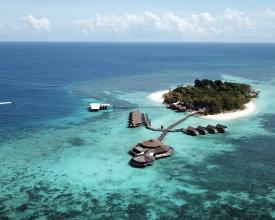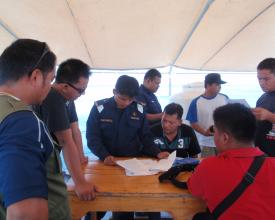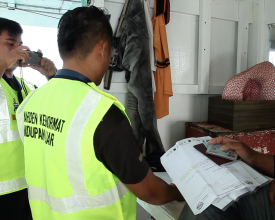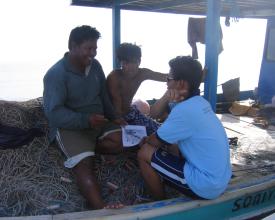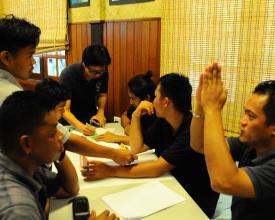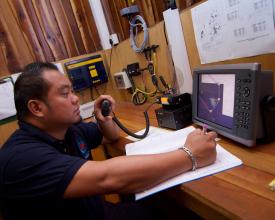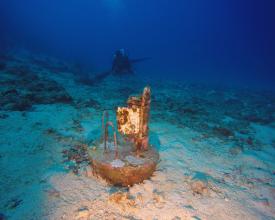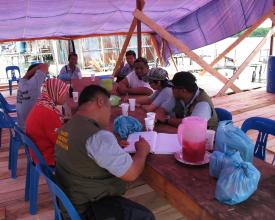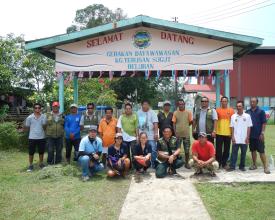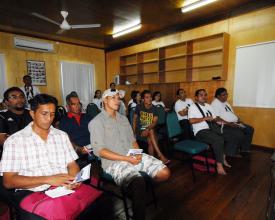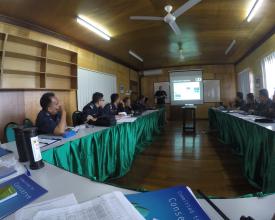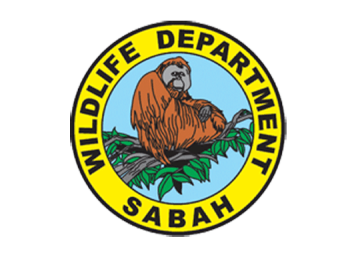
Effective Enforcement Strategy in the Sugud Islands Marine Conservation Area
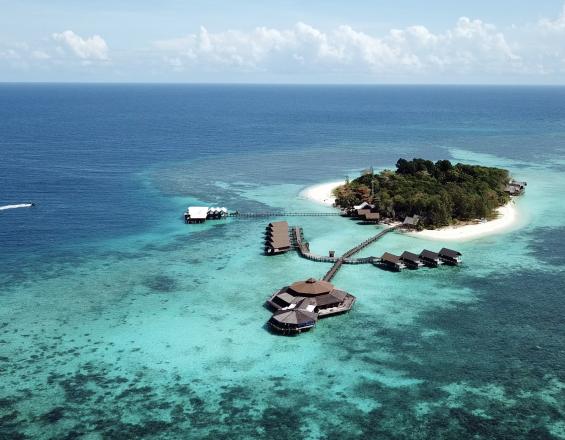
Through the investment of technologies, the effective enforcement strategy and engagement with the stakeholders in reducing illegal fishing activities within the Sugud Islands Marine Conservation Area (SIMCA) are effective.
Contexto
Défis à relever
The encroachment of illegal fishing inside SIMCA continues to be a threat, and enforcing the no-fishing policy with a large area around SIMCA can be challenging. In large no-take marine reserve, enforcement can be insufficient to cover the whole area because of limited resources and manpower. Furthermore, fishers tend to alter their fishing schedule to fish illegally when enforcement presence is limited.
Ubicación
Procesar
Summary of the process
The combined four building blocks are to achieve an effective enforcement strategy. The enforcement guideline and strengthening capacity building (Building Block 1) ensure the Reef Guardian enforcement team has a systematic procedure to conduct sea patrol. The guideline emphasized steps from pre-sea patrol preparation, crew safety, boat intercept, boat check, evidence search and preservation, data records, police report filing, and proper documentation before the handover for authorities for court prosecution. The successful detection of illegal fishing within SIMCA relies on the radar tracking system's information (Building block 2), where illegal fishing activities can be predicted. Reporting of illegal fishing or activities enhanced through the engagement of fishing communities (Building block 3). Illegal fishing impact not only MPA performance but also the livelihood of the fishing communities. Multi-stakeholders' collaboration is needed to ensure the intrusion of illegal fishing to fishing community fish grounds and marine protected area are reduce (Building block 4).
Building Blocks
Enforcement Guideline and Capacity enhancement
Effective enforcement relied on the main four steps from Step 1 on detection of illegal fishing, Step 2 on successful detention of the suspect, Step 3 on the case prosecution and Step 4 on the criminal conviction. The Reef Guardian enforcement team plays an essential role in the early process of detecting illegal fishing. Enforcement guideline has been used to standardize the sea patrol operation, ensure the team safety and efficiency from boat check, and preserve all criminal evidence (protected species, illegal fishing equipment/substances). The guideline has been used as capacity training for systematic enforcement procedures to the recruit.
Enabling factors
- Experiences sharing from partners and team members to develop a straightforward strategy and guideline.
- Sabah Environmental Court workshop emphasized the important preservation of the evidence for successful court prosecution and conviction.
Lesson learned
- Clear enforcement strategy procedures are essential for effective sea patrol.
- Many cases fail in prosecution because of failure in evidence preservation for court prosecution.
- Delegate each enforcement crew's task in each sea patrol operation to ensure the effective detention of illegal fishing vessels.
Advanced technologies enhance surveillance
Investment in a radar tracking system for broader monitoring of the area. The radar tracking system is real-time monitoring speed, and directional heading of the boat in the marine protected area's vicinity. The radar information can infer the type of activity of the boat is likely to be engaged in the sea. For example, a fish trawler boat that is trawling tends to move at a slower speed of 7-10 kph than a passing trawler that usually travels at a speed of 16 – 20 kph. Furthermore, five blast detectors were installed to monitor and analyse blast fishing activities within SIMCA. The blast detector's information enables the Reef Guardian enforcement team to do strategic sea patrol to increase enforcement presence in the hot spot where illegal fish bombing often occurred.
Enabling factors
- Investment from a partner organization (Conservation International Philippine) on a radar tracking system in 2009.
- Joint partnership with Reef Defender from Hong Kong since 2014 in the mission to reduce fish bombing in the region.
Lesson learned
- Information from the radar reduces operational cost (boat fuel) where the team show enforcement presence on the hot spot areas, instead of patrolling the entire marine protected area.
- Radar information is best for night enforcement activities. The information giving a higher chance to intercept illegal fishing activities on the spot which lead to higher success on detection and detention rates.
Enhance awareness and engagement with the local fishing communities
The illegal fishing practice, such as illegal fish trawling at the shallow area local communities fishing grounds, impacts the sustainability of marine resources and the livelihood of local fishing communities. Implementing awareness programmes to the fishing communities and engaging them to be eyes and ears in reporting on the potential illegal fishing or activities in the sea.
Enabling factors
- The concern of fishing communities in the reduction of their catches from the illegal fish trawling in their common fishing grounds
- Illegal fishing impact the fishing communities livelihood.
Lesson learned
- The engagement with fishing communities widens the enforcement capacity in a more extensive area.
- The collaboration between Reef Guardian (Private sector) and fishing communities (stakeholders) safeguard marine habitats and reduce threats for the long-term sustainability of resources.
Joint collaborative enforcement
The success of enforcement work relies on collaboration from the authorities. The SIMCA Enforcement Steering Committee has been established to reduce illegal fishing activities within the marine protected area. The steering committee included Reef Guardian, Sabah Wildlife Department, Department of Fishery, Marine Police, Malaysia Navy, District Offices, Malaysia Maritime Enforcement Agency and Eastern Sabah Security Command. The Joint collaborative enforcement activities were conducted regularly to ensure efficiency in handling threats in illegal fishing, wildlife poaching and trafficking, illegal immigrant, and piracy issue within and outside of the marine protected area.
Enabling factors
- Close relationship with stakeholders
- Persistency of partners to take action
- Clear marine threats information for the authorities to plan for their actions
Lesson learned
- Effective enforcement needs collaboration from stakeholders from information gathering, consistence patrolling, effective detection and detention for court prosecution and crime conviction.
Impacts
In 2006, joint collaborative enforcement with marine police successfully apprehended three fishing bombing activities. The successful prosecution results in dramatic drops in the fish bombing in the region. In 2009, another foreign fishing illegal fish inside SIMCA was detained. The incident awakened the authorities' for more enforcement presence needs to secure Sabah’s marine resources. The sea patrol activities assisted by the land-based radar tracking team reduced illegal fishing to almost zero within SIMCA in the daytime since 2008. The enforcement operation procedure or guideline has been used as an enforcement training module for other agencies in Sabah, Malaysia.
Beneficiaries
Marine ecosystem
Ecotourism
Marine resources
Fishing communities
Sustainable Development Goals
Story
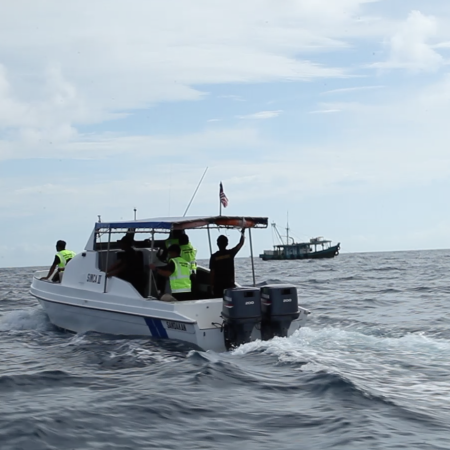
In 2004, Reef Guardian only consisted of 5 members to manage and run conservation programmes in SIMCA. None of the staff was trained to carry out enforcement and has no sense of proper enforcement work. The sea patrol was carried out on schedule once a week, with no standard operating procedure and safety concern. Fish bottom trawling was rampant back from 2004 to 2008. In single sea patrol, the Reef Guardian team encountered a maximum of up to 12 fish trawler boats inside the marine protected area. In 2005, the radar tracking system was fully utilized by manually record data on the boat in and out inside SIMCA. Capacity training was given to staff to handle radar, interpret radar information, sea navigation, and night navigation. In the same year, the team was trained and certified as the Honorary Wildlife Warden by the Sabah Wildlife Department.
With the certification, the team can stop and search for the fishing boat. In 2008, in partnership with the National Fish and Wildlife Foundation, Reef Guardian implemented an interpretative enforcement strategy. All fishing boats that stopped were brief on the SIMCA border, and the boat captain and the crews acknowledged the rules and regulations. In 2009, a foreign bottom trawling vessel was detained but failed in the process of prosecution. The failure was a result of the poor preservation of evidence. A lesson learned later the team strengthened the enforcement work through collaboration with the enforcement agencies. Firstly, by organising the annual environmental programme (Project Aware) that involved enforcement agencies and the fishing communities. Following this, the SIMCA enforcement steering committee was established with various enforcement agencies to discuss and combat illegal fishing activities in and outside of marine protected areas. To date, fish trawling within SIMCA reduced to almost zero in the day time. However, the conservation area's encroachment is continuing in the night hour, mainly after midnight to dawn.

